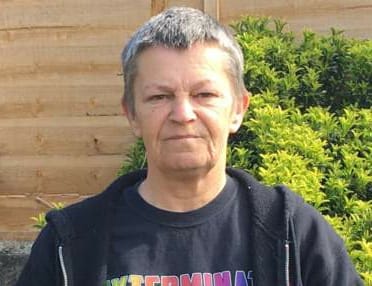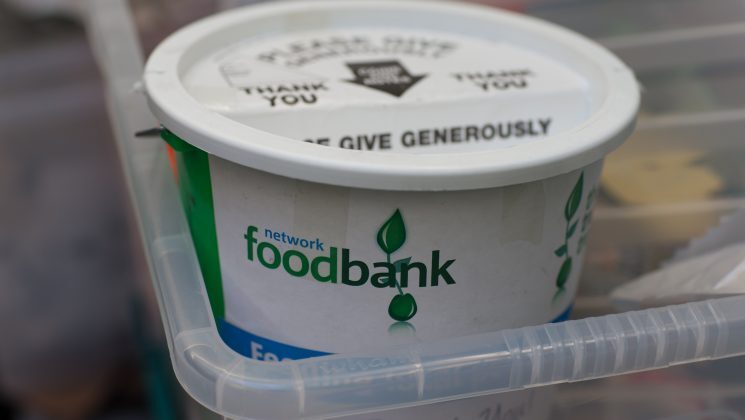While statistics can help define the problem, the figures don’t paint the full picture. We spoke to Pat and Niall, two UNISON members who can see, first hand, the effects of the cost of living crisis.
Pat Jones

Pat Jones is a care worker and is secretary of UNISON’s Ymlaen/Forward branch. She’s wearing a thick woollen jumper and when her friend, who lives with her, brings her a cuppa she says: “When I’m working from home, we try to sync our coffees, so we don’t have to boil the kettle twice. It’s daft isn’t it?”
I spoke to Pat in April. When I ask how the cost of living crisis is affecting her, and the members she speaks to, she says: “You don’t see t-shirts so much, these days. People are sitting in their houses, cold. Because they’re too afraid to put their heating on. If you do Teams calls with people, they’re normally in onesies, dressing gowns or jumpers.”
But Pat feels lucky. She lives quite close to her main worksites and, if she must, she can walk to work rather than take the car. Although, walking back in the dark at the end of a 12 or 24-hour shift is less than ideal. For her colleagues who live further out, fuel is becoming increasingly unaffordable. Some have resorted to using their over-60s bus passes to get into work, adding two hours of commute onto already exhausting shifts.
She’s lucky, she says, as she’s not a massive eater, at least in comparison to her grandsons, who ‘eat like horses’. But in Wales, a Sunday roast is a family-centred tradition. She speaks to colleagues and members who are now going without because they can’t afford the meat. She also explains how it’s becoming increasingly difficult for her and other people to make healthy choices when cooking, as often the unhealthy options are cheaper.
Pat also says she’s lucky that she’s a branch secretary. This means she’s ‘bought out’ from her job for 36 hours a week, and doesn’t feel the same level of pressure as some of her colleagues to cover extra shifts at the last minute, as she is already committed to union work.
Occasionally, she also gets to travel for meetings or conferences. On those weekends, she doesn’t have to worry about the heating, or getting food and milk in. And, as she’s just been re-elected, over the next year those weekends will become times when she can sleep in a proper bed.
Niall McCarroll

“The cost of living crisis is like a revolving door,” says Niall. He works as a member of a support team at a supported living organisation, which supports homeless families: it gives them a safe place to stay, allows them to get back on their feet financially, and assists them in moving back into their own homes in the community.
“We’re noticing now that we have an increasing number of service users who, whenever they move out of the service into their own home, are unable to get by because gas, electricity and food is increasing in cost. So we’re getting more people referred back in.”
Having worked in the homelessness sector for over two decades, Niall has seen a massive change in his work. When he started, it would usually take around 12 months between a family moving in then moving back into the community. Now it is significantly longer, not least because the needs of these homeless families are becoming ever more complex, with factors that could lead to homelessness including domestic violence and drug use.
Niall is increasingly finding that, in the initial budgeting assessment they do with families, there simply isn’t enough income for them to financially support themselves outside of supported living settings. It’s certainly becoming more difficult, with food-bank use on the rise.
“We notice it [the rising cost of living] in terms of the appearance of these young parents and their children. There’s a lot of depression and stress and anxiety and it’s very hard for people to stay motivated and positive when your ideas of what life you wanted to have are being pushed further away.
“We have families who were using the service 20 years ago, who have other family members now using the service because they don’t have the means to lift themselves out of poverty. It’s a revolving door.”
Niall is also chairperson of the Northern Ireland community and voluntary branch. In that role he sees the toll that the cost of living is taking on the C&V workforce.
“A lot of workers are leaving the sector now, experienced and genuinely caring community workers being lost to a system that just won’t value this type of work,” he says. “The complex and challenging workload, and the responsibility and expectations associated with this work, simply don’t reflect the take home pay.
“People are having to work three or four extra shifts a month, in real terms having to work another week on top of their contracted hours to make ends meet.





massive increase in homelessness in this country already the numbers have risen so all services face pressures in trying to support the most vulnerable in our society today.
The situation stands for homelessness to be getting increasingly more likely for a greater number of people with no funding available to support we (country) need to be more active in voicing our concerns to central government.